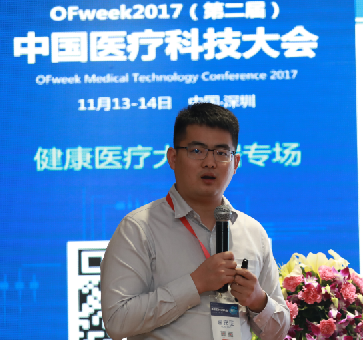On November 13th, the “Weweek 2017 (2nd) China Medical Technology Conference†hosted by OFweek China Hi-Tech Industry Portal and held by OFweek Medical Technology Network was held in Shenzhen. Dr. Chen Hao, the founder and chief scientist of the medical school, and the Chinese University of Hong Kong, shared the application and thinking of artificial intelligence in medical imaging. Vision Medical Technology is a high-tech, innovative company incubating by the Chinese University of Hong Kong Medical Imaging Computing Analysis Laboratory. The founding team is a professor and doctoral team of the Chinese University of Hong Kong and a global top 500 executive. The core is to automatically analyze and identify medical image big data based on computer medical image analysis and artificial intelligence technology. It aims to develop high-quality medical image analysis software and large-scale image analysis platform for public/private hospitals, third-party independent images. The testing center, medical imaging equipment provider and other user groups provide high-performance, low-cost computer-aided diagnostic products, services and solutions.            Vision Medical Chairman Chen Hao In the speech, Chen Hao first introduced the direction that needs to be perfected in the field of medical imaging. He believes that at present we need to do four things, one of which is the medical imaging AI auxiliary diagnosis system. The diagnostic system is divided into three directions, a radiation-assisted diagnosis system, a radiotherapy-assisted diagnosis system, and an AI pathology-assisted diagnosis system. Among them, radiotherapy belongs to the direction of radiation, so there are two main directions. There are two special responsible teams for medical technology, radiation-assisted diagnosis and pathological diagnosis system. Assist doctors by treating pathological images, such as marking of lesions, qualitative judgment, quantitative measurement, three-dimensional modeling, and the like. Second, the remote diagnostic platform is built. Through our platform, our modular tools combine doctoral experts and provide services to hospital patients at all levels across the country. Third, cooperation with PACS vendors, imaging equipment vendors, and third-party platforms. We have built a related platform in Hong Kong, a medical imaging computing center and a big data center under construction in Shenzhen. The data we have recently received is hundreds of terabytes of data. Before processing 1000 people, it took a month to get results from three servers at the beginning of the year. With the current technology, we can produce results in half a day, so the necessity of building a medical imaging computing center does exist. Fourth, solve the current medical dilemma, that is, the shortage of medical resources. As an example, the annual growth of radiology data is 30%, while the growth rate of doctors is only 1%, and the growth rate of data far exceeds the growth rate of doctors. The second is about the pathology department. At present, there are 9,000 pathologists in China, and the gap is more than 50,000. The work scene of doctor + artificial intelligence is able to help solve this dilemma. For the future development of artificial intelligence + medical imaging, Chen Hao said: "The predecessor of artificial intelligence is computer-aided analysis. Its two cores are lesion detection and quantitative analysis, which can reduce the burden on doctors, improve work efficiency, reduce errors, and assist Influencing diagnosis to achieve the ultimate benefit for patients. At present, the challenges faced by artificial intelligence medical imaging include data quality; clinical embedding, close to clinical use; generalization ability, different algorithms for algorithm or company R&D personnel, different hospitals The generalization ability of the images scanned by the manufacturers and different devices is what we are doing the most; the other is maintainability, the maintenance is simple; the functional ease of use is to be satisfied. The doctor's needs are in line with the doctor's habits." For more details, please pay attention to the follow-up reports of OFweek Medical Technology Network!
Bladder catheters are often used in postoperative patient treatment or a balloon catheter can also be used in a care facility for micturition disturbances. It often comes into use in postoperative care in hospitals, urology practices and care facilities.
Yingmed offers a wide selection of disposable catheters with different materials from PVC catheter and Latex foley catheter to All silicone. None, single or double balloon, Single way, 2-way and 3-way, you will find your ideal catherter according to the use and physical structure of female and male. All of the Bladder catheters are packed with individual sterilized PE bag or paper bag.
Balloon catheters are securely fitted with an inflatable balloon in the bladder. The balloon volume of the catheter is chosen based on the anatomical circumstances so as to prevent unwanted sliding out.
As transurethral catheterization is an invasive operation. It`s application must be weighed against the risk of urinary tract infections. Operators must make sure the operation is under a sterile environment. Combined with catheterization, Yingmed also offers a large assortment of consumable disinfect and isolation products like Cotton ball, Gauze swab, Non-woven fenestrated drapes, Surgical gloves, Disposable plastic forceps. You will find them in our category of Wound Dressing. If you were not able to find the correct product, simply contact with us and we will attempt to help.
Latex Foley Catheter,Disposable Nelaton Catheter,Single-Use Urine Catheter,Pvc Nelaton Catheter NINGBO YINGMED MEDICAL INSTRUMENTS CO.,LTD , https://www.chinayingmed.com